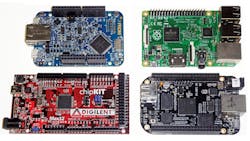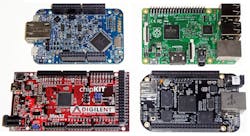This file type includes high resolution graphics and schematics when applicable.
Platforms like Arduino, Raspberry Pi, and BeagleBone (see figure) are ubiquitous in the maker movement. The question is whether these platforms can be used in production products. The answer is often yes, depending upon specific application requirements.
Each of these platforms has a large and growing community that encompasses both vendors and developers. The plethora of peripheral expansion boards is key to their success and many silicon vendors target new products at these platforms. This greatly simplifies deployment while making the product available to a wider audience.
Likewise, microcontroller and microprocessor vendors can deliver boards compatible with these peripherals. Freescale’s Freedom boards are compatible with the Arduino platform. Digilent’s chipKit Max32 can use Arduino shields (expansion boards), but runs a Microchip 32-bit MIPS-based PIC32. The challenge for vendors is determining which platform to select.
There can be challenges for designers especially when it comes to rugged requirements. Most platforms have moved to form factors that allow board stacks to be bolted together. Designers need to take a closer look at boards to make sure they meet interface requirements (such as isolation) that are common on production platforms like PC/104, but often overlooked in the products that target the maker community, where cost or time-to-market is often more critical.
Customizing Designs
Many of the platforms are based on open-source hardware. This allows a designer to easily move to a custom solution that can do a number of things: from making a design harder to clone, to providing a more compact solution, to reducing cost. It also means a company can replicate a board if the source becomes unavailable or too expensive. Many reference designs also fall into this category, as chip vendors are usually more interested in selling chips than licensing board designs.
The challenge facing many developers is the difficulty inherent to moving to a custom solution—especially for developers that are more software-oriented. There are many design firms that can help turn prototypes into products, but costs can vary. On the plus side, the resulting solution usually provides advantages such as lower per-unit cost, a more compact footprint, and possibly lower power requirements. A custom design can also be more robust with the inclusion of additional isolation and interface protection.
Still, converting a design to a custom solution can take time and money. There are companies looking into lowering these barriers. Newark/Element14 can now deliver customized versions of the Raspberry Pi. This might include chores like removing unneeded interfaces and connectors.
Gumstix’s Geppetto can generate custom boards for a fixed $2,000 set-up fee. The web-based design tool even shows the per-board cost as the board is laid out. It can be used to create boards compatible with popular platforms like the BeagleBone, as well as supporting COM modules like the Gumstix Overo and select microcontrollers like STmicroelectronics' STM32F427 Cortex-M4.
Geppetto differs from other custom approaches because it limits the devices and connectors that can be included on a board. On the other hand, designers only need to layout a board from the component level and the system will only build a board that has met all the component requirements. For example, a microcontroller will need power and an Ethernet jack will require matching support by the processor.
This file type includes high resolution graphics and schematics when applicable.
About the Author
William G. Wong
Senior Content Director - Electronic Design and Microwaves & RF
I am Editor of Electronic Design focusing on embedded, software, and systems. As Senior Content Director, I also manage Microwaves & RF and I work with a great team of editors to provide engineers, programmers, developers and technical managers with interesting and useful articles and videos on a regular basis. Check out our free newsletters to see the latest content.
You can send press releases for new products for possible coverage on the website. I am also interested in receiving contributed articles for publishing on our website. Use our template and send to me along with a signed release form.
Check out my blog, AltEmbedded on Electronic Design, as well as his latest articles on this site that are listed below.
You can visit my social media via these links:
- AltEmbedded on Electronic Design
- Bill Wong on Facebook
- @AltEmbedded on Twitter
- Bill Wong on LinkedIn
I earned a Bachelor of Electrical Engineering at the Georgia Institute of Technology and a Masters in Computer Science from Rutgers University. I still do a bit of programming using everything from C and C++ to Rust and Ada/SPARK. I do a bit of PHP programming for Drupal websites. I have posted a few Drupal modules.
I still get a hand on software and electronic hardware. Some of this can be found on our Kit Close-Up video series. You can also see me on many of our TechXchange Talk videos. I am interested in a range of projects from robotics to artificial intelligence.



